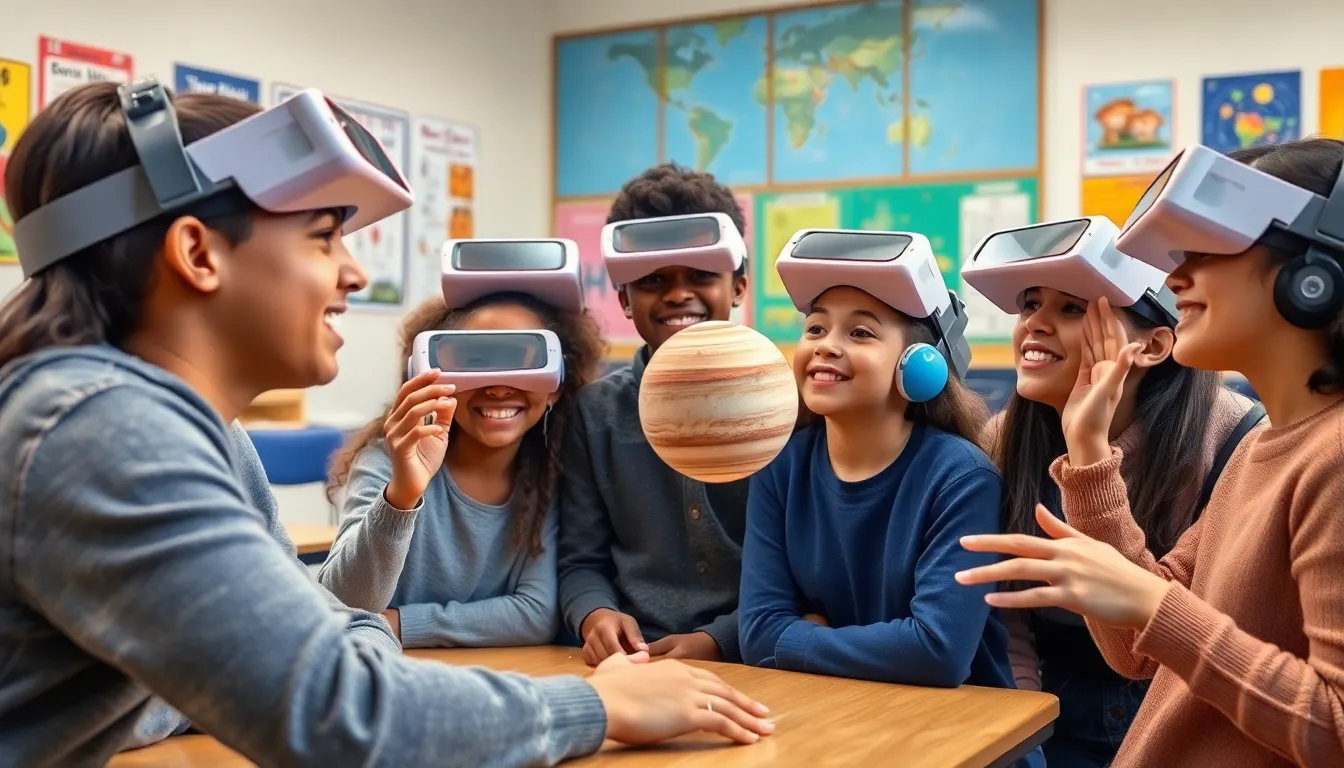Augmented reality is transforming the way people interact with the world around them. By overlaying digital information onto the physical environment, it creates immersive experiences that blend reality with virtual elements. This technology isn’t just for gaming; it’s revolutionizing industries from education to healthcare.
As businesses and consumers alike embrace augmented reality, its applications are becoming increasingly diverse. From enhancing shopping experiences to improving training methods, AR is reshaping how individuals engage with information and each other. The future of augmented reality holds exciting possibilities that could change daily life, making it essential to understand its potential and implications.
Table of Contents
ToggleWhat Is Augmented Reality?
Augmented Reality (AR) merges digital elements with the real world, enhancing the user’s perception of their environment. Unlike virtual reality, which creates immersive digital worlds, AR overlays information in real time. Through devices such as smartphones, tablets, and AR glasses, users experience interactive visuals and sounds that complement their surroundings.
Applications of AR span multiple sectors. In education, AR brings subjects to life by providing interactive 3D models, which aid in deeper understanding. In healthcare, AR assists in surgical procedures by displaying vital data directly onto a surgeon’s field of view. Retailers use AR to create virtual fitting rooms, allowing customers to try on clothes before purchasing.
The technology utilizes sensors, cameras, and displays, facilitating seamless integration between real and virtual components. Popular AR platforms include Microsoft’s HoloLens and smartphone applications like Pokémon GO. As AR technology continues to develop, its influence on daily activities and consumer engagement expands, providing new avenues for businesses to interact with customers.
Applications of Augmented Reality

Augmented reality significantly impacts various sectors, enriching user experiences and engagement. Key applications include entertainment, education, training, and healthcare.
Entertainment and Gaming
AR revolutionizes the entertainment and gaming industries by immersing users in interactive experiences. Popular games like Pokémon GO use AR to merge digital characters with real-world environments, motivating players to explore their surroundings. Moreover, AR enhances live performances and concerts by adding digital visuals, creating memorable experiences for audiences. Companies like Niantic continue to innovate, developing AR platforms that encourage physical activity while entertaining users.
Education and Training
In education and training, AR transforms traditional learning methods into interactive, engaging experiences. Interactive 3D models allow students to explore complex subjects, such as anatomy or physics, making abstract concepts tangible. Educational platforms, like Google Expeditions, facilitate virtual field trips, bringing learners to historical sites or scientific environments without leaving the classroom. Training simulations in industries like aviation and military utilize AR for realistic, risk-free practice, enhancing skill retention and readiness.
Healthcare
Healthcare applications of AR improve patient outcomes and medical training. Surgeons utilize AR for enhanced visualization during operations, overlaying critical information directly onto their field of view, which aids in precision. AR also supports remote consultations, allowing doctors to guide patients through procedures from afar. Medical training programs incorporate AR for realistic practice scenarios, enabling students and professionals to refine their techniques safely and effectively. Companies like Microsoft and GE Healthcare continue to advance AR technology in the medical field, contributing to innovative solutions.
Advantages of Augmented Reality
Augmented reality (AR) offers several advantages that transform user interaction and engagement across various sectors. These advantages include enhanced user experience and improved engagement, both vital for maximizing the technology’s potential.
Enhanced User Experience
Enhanced user experience through AR creates deeper connections between users and their environment. AR provides real-time, context-aware information, allowing users to interact with their surroundings more intuitively. In retail, virtual fitting rooms enable customers to try on clothes without physically wearing them, streamlining shopping and increasing satisfaction. In education, interactive 3D models facilitate an immersive learning process, making complex subjects easier to understand and retain. Moreover, AR helps simplify tasks, especially in industries like construction and maintenance, by overlaying instructions directly onto equipment or workspaces, leading to a more efficient workflow.
Improved Engagement
Improved engagement results from AR’s ability to make interactions more captivating and meaningful. In gaming, AR integrates digital elements with real-world settings, providing immersive experiences that keep players motivated and entertained. For businesses, AR marketing campaigns attract consumers’ attention more effectively than traditional advertisements. For instance, an AR app that allows users to visualize how furniture fits in their homes encourages user interaction and promotes sales. Educational institutions leveraging AR create memorable lessons, increasing student participation and fostering a love for learning. Enhanced engagement leads to stronger connections between brands and consumers, driving loyalty and continued use of AR applications.
Challenges and Limitations
Augmented reality (AR) faces various challenges and limitations that affect its widespread adoption and effectiveness. These challenges can hinder user experience and raise important concerns.
Technical Barriers
Technical barriers significantly impact the development and utilization of AR. These include:
- Hardware Limitations: AR requires advanced devices with high processing power and capable sensors. Many existing smartphones and tablets lack the necessary specifications for optimal AR experiences.
- Software Compatibility: Many AR applications face compatibility issues with different devices and operating systems. Relying on proprietary platforms limits broader accessibility.
- Latency Issues: Delays between user actions and system responses can disrupt the AR experience. High latency affects app performance, resulting in frustration for users.
- Environmental Factors: AR performance can be hindered by inadequate lighting or cluttered environments. Users often encounter challenges in outdoor spaces with varied light conditions.
Privacy Concerns
- Data Collection: AR applications often collect vast amounts of personal data, including location and usage patterns. Users may unknowingly share sensitive information, leading to privacy violations.
- Surveillance Risks: The use of AR glasses or devices in public spaces can raise surveillance concerns. The potential for unauthorized recording of individuals without consent poses ethical dilemmas.
- User Trust: The need for transparency regarding data handling practices is vital. Users may hesitate to adopt AR if they distrust the platforms and fear misuse of their information.
The Future of Augmented Reality
The future of augmented reality (AR) presents exciting possibilities as technology continues to evolve. Expectations indicate that AR will become increasingly integrated into daily life across various domains, such as entertainment, education, and healthcare.
Advancements in AR hardware and software significantly contribute to its potential. Innovations in AR glasses, for example, promise enhanced functionality and lower costs. These developments could lead to broader consumer adoption and commercial use. Companies like Google and Apple are actively investing in AR projects, fostering competition that drives the industry forward.
Potential applications of AR extend into fields such as tourism and real estate. In tourism, AR can enhance the travel experience by providing interactive guides that offer historical information and local insights. In real estate, virtual property tours can allow potential buyers to explore homes without physically visiting them.
Collaboration between AR and artificial intelligence (AI) is another future trend. AI can improve AR experiences by personalizing content and optimizing interactions. For instance, AI-driven analytics could tailor supplement information and recommendations to users based on their preferences and behaviors.
Education is poised for substantial transformation through AR. Interactive learning environments can engage students more effectively and facilitate remote education. AR can simplify complex subjects through visual aids, helping students grasp challenging concepts.
Healthcare systems stand to gain improved patient outcomes through AR-enhanced tools. Surgeons can utilize AR overlays during procedures for enhanced precision, while medical professionals can practice skills in simulated environments. These applications can lead to better training for healthcare workers and more effective patient care.
Challenges such as privacy concerns and technical limitations must be addressed for AR to thrive. As the technology grows, regulations surrounding data protection should evolve to build user trust. Manufacturers must prioritize user privacy while developing AR solutions.
Ultimately, the future of augmented reality promises significant advancements that could reshape how individuals and businesses interact with their environments. Continued innovation in this space suggests that AR will become an essential part of daily life, enriching experiences and improving various sectors.
Augmented reality is set to redefine the way individuals and businesses engage with the world around them. As technology advances and becomes more accessible, the potential applications of AR will continue to expand across various sectors.
From enhancing educational experiences to revolutionizing healthcare practices, AR’s versatility is undeniable. The collaboration with artificial intelligence further enhances its capabilities, promising personalized and immersive interactions.
While challenges remain, including privacy concerns and technical hurdles, addressing these issues will pave the way for broader adoption. The future of augmented reality is bright and filled with opportunities that could significantly enrich everyday experiences.









